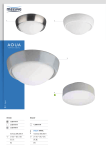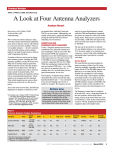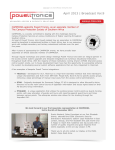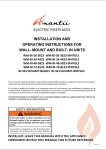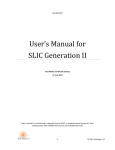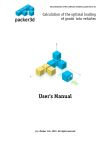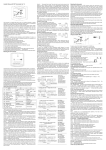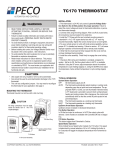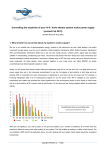Download M&V Geyser Guideline _Draft_ v2r1
Transcript
Corporate Services Division Corporate Technical Audit Department Contracted the North-West North West University to execute this project The Measurement and Verification Guideline: Geyser Insulation Distribution Projects (Draft) Project Name: M&V Guideline: Geyser Insulation Distribution Project Number: N/A Report Type: M&V Geyser Guideline Reporting Period: N/A Report Issue Date: Report Number: Revision Number: 30 APRIL 2008 PM/M&V/NWU - 07/08 – M&V Geyser Guideline (Draft) v2r1 M&V Geyser Guideline (Draft) v1r11 Compiled by: ……………………………………………… IE Bosman M&V Team member North-West University Date: 14 May 08 Authorised by: ……………………………………………… CA van der Merwe NWU M&V Leader North-West University Date: 14 May 08 Accepted by: ……………………………………………… Vuyo Mini CTAD Corporate Services Division Eskom Date: ………….. PAGE II Table of Contents 1 INTRODUCTION .................................................................................................................... 2 2 OVERVIEW OF GEYSER INSULATION DISTRIBUTION PROJECTS .............................. 13 3 METERING PROCEDURES AND CHARACTERISATION ................................................... 2 3.1 METHODOLOGY ................................................................................................................ 2 3.2 SYSTEM USED TO DEVELOP METHODOLOGY ............................................................. 4 3.3 METERING .......................................................................................................................... 5 3.4 FILTERING OF NON-STANDING LOSSESS EVENTS ..................................................... 6 3.5 DETERMINING THE GENERIC EQUATION ...................................................................... 7 3.5.1 Determining a generic equation for an un-insulated geyser ..................................... 7 3.5.2 Determining a generic equation for an insulated geysers ......................................... 8 3.6 SUMMARY .......................................................................................................................... 9 4 EVALUATION OF GEYSER AND PIPE INSULATION DISTRIBUTION PROJECTS........ 10 4.1 ISSUES TO CONSIDER ................................................................................................... 10 4.2 CHARACTERISATION AND METERING PROCEDURE ................................................ 10 4.3 GEYSER BLANKET AND PIPE INSULATION STATISTICAL MODEL.......................... 12 4.3.1 Fieldworker Form (Installation visit) ........................................................................ 13 4.3.2 Fieldworker Form (Follow-up visit) .......................................................................... 13 5 GEYSER INSULATION M&V TOOL - USER MANUAL...................................................... 14 5.1 Add new project .......................................................................................................... 14 5.2 Open existing project .................................................................................................. 14 5.3 Fieldworker form......................................................................................................... 15 5.4 Admin ......................................................................................................................... 19 5.5 User Queries .............................................................................................................. 23 5.6 Help ............................................................................................................................ 24 APPENDIX A ........................................................................................................................... 25 APPENDIX B ........................................................................................................................... 27 APPENDIX C ........................................................................................................................... 29 APPENDIX D ........................................................................................................................... 31 PAGE III Nomenclature: NWU North-West University M&V Measurement and Verification DSM Demand Side Management Te Environmental Temperature Ts Set Point Temperature m Slope ID Identification Number CPUT Cape Peninsula University of Technology PAGE IV GEYSER INSULATION DISTRIBUTION PROJECT -GUIDELINE 1 INTRODUCTION NWU M&V team was requested by Eskom to develop a standard methodology and procedure to determine the impact of installing geyser and pipe insulation. This standard methodology and procedure will reduce the amount of work needed during a national roll-out campaign. This report is the draft geyser insulation guideline and needs to be approved by all the M&V teams before the finalisation of the guideline. The guideline includes a description of the methodology and procedures followed to characterise the impact of geyser blankets on the standing losses, extension of the methodology to pipe insulation and a user manual for the application. 2 METERING PROCEDURES AND CHARACTERISATION The NWU M&V team evaluated a sample set of geysers to characterise the influence of geyser blankets on standing losses. The methodology followed is described in this section. The results from this study formed the foundation for the application developed. The purpose of the application was to determine the impact of geyser blankets and pipe insulation, on standing losses. In order to quantify and assess the savings, some measurements and calculations needs to be made. Expenditure on measurement and assessing of savings should be dependent on the amount the project will save on electricity. In other words; if a project will only save a little, it is not viable to spend huge amounts of money on the measuring equipment in order to verify the savings. South Africa has a relatively warm climate and therefore much smaller temperature differences, (environmental versus geyser temperature), than areas with colder climates. The impact of installing geyser blankets on the standing losses of a geyser in South Africa, is therefore smaller. Another issue is that a sample of geysers are normally scattered over a large area, making the measuring of the impact expensive (one meter per geyser). If every geyser would have been measured, the savings resulting from the installation of geyser blankets will be lost in the cost of the metering equipment. It was therefore a requirement to develop a methodology to determine the impact of geyser blankets without measurements. The following section will describe the methodology followed to determine the impact of geyser blankets on the standing loses. 2.1 METHODOLOGY In order to determine the baseline (the electricity use of the geysers without DSM intervention) the following variables need to be taken into consideration: • Geyser Set point (Temperature) • Water usage PAGE 2 GEYSER INSULATION DISTRIBUTION PROJECT -GUIDELINE • Environmental temperature • Size of geyser • Geyser blanket characteristics The electric power is therefore a function of several variables: IPkW = f (X1, X2, X3, X4, X5, X6)…[1] Where: IPkW = Electric power X1 = Geyser Set point X2 = Water usage X3 = Environmental temperature X4 = Size of geyser X5 = Geyser blanket characteristics X6 = Maintenance on geyser blanket A number of the above mentioned variables could be eliminated from the function: • Water usage: It can be assumed that the water usage before and after implementation will remain the same because nothing was installed to change the water usage pattern. • Geyser Blanket characteristics: Can be omitted from the equation because all the geysers were fitted with the same type of geyser blankets. • Maintenance: Maintenance on the geyser is only a value 0 or 1 to verify if a geyser blanket is installed (1) or not (0). Therefore the only things remaining that influence the standing losses are the following: IPkW = f (X1, X2, X3)…[2] Where: IPkW = Electric power X1 = Geyser Set point X2 = Environmental temperature X3 = Size of geyser The methodology is based on finding a relation between geyser standing losses, set point water temperature (thermostat setting) and environmental temperature. This would simplify future projects because only the thermostat setting and the environmental temperature will be required to determine what the standing losses would be over a certain period. Impact of installing geyser blankets could be easily determined in current and future M&V projects. PAGE 3 GEYSER INSULATION DISTRIBUTION PROJECT -GUIDELINE 2.2 SAMPLE USED TO DEVELOP METHODOLOGY METH The sample (shown in Figure 1) 1 comprises of nine identical geysers installed in a residential apartment complex in Potchefstroom. All the geysers are installed on an outside wall, have a 100-litre litre capacity and a 2kW heater heate element. The geysers have thermostats that can be manually adjusted so that the supplied water temperature can be regulated. The thermostats of the geysers were set to either 60°C or 70° 70°C C and were not change d for the rest of the metering period. These thermostat hermostat settings are typical for geysers in residential areas. Figure 1: Sample used (bottom row) in determining the methodology (without geyser blankets) determination. The Six of the nine geysers were fitted with geyser blankets after baseline determination geysers with the geysers blankets are shown in Figure 2. A “before” and “after” phase can clearly be distinguished.. Using the “before” relations as the baseline and the “after” relations as the actual values, energy savings could be determined. GEYSER INSULATION DISTRIBUTION PROJECT -GUIDELINE Figure 2: Geyser blankets installed 2.3 METERING To find a relation between geyser standing losses, thermostat setting and environmental temperature the following measurements are needed (Measurement configuration shown in Figure 3): 1. Electricity consumption (measured in amps, assumed voltage to be 230V). This measurement is a direct indication whether the geyser used power or not. 2. Environmental temperature. Temperature data from the South uth African Weather Bureau can be used. 3. Hot water temperature. ture. Installing flow meters is an intrusive process and therefore not viable. The quantity of water consumed is negligible, as only periods when no water was used were studied to determine geyser standing losses. Measuring the temperature of the hot ot water supply pipe is a direct, non-intrusive non intrusive technique to determine when hot water was consumed. This measurement indicates ndicates whether the element of the geyser switched itched on to restore the water temperature, (the temperature dropped due to hot water consumption or standing losses losses). GEYSER INSULATION DISTRIBUTION PROJECT -GUIDELINE Temperature measurement Electrical energy measurem ent Figure 3: Geyser installation and metering points A “before” case was developed in the period three months prior to the installation of geyser blankets. Logging intervals were 5 minutely. 2.4 FILTERING OF NON-STANDING LOSSES EVENTS Only periods when no hot water was consumed would be considered to determine the geyser standing losses. It was therefore necessary to isolate events where hot water was consumed and the geyser switched on as a result. Figure 4 indicates events of consumption of hot water from the geyser. The graph on the left shows the energy consumption. On the right hand side, the hot water supply pipe (top line) Temperature °C Energy consumption [W] and the environment (bottom line) temperatures are shown. Figure 4: Temperatures of water supply pipe (top) and environment (bottom) Three encircled peaks can be seen; these peaks indicate the events when the heating elements switched on. The temperature graph indicates the events when hot water was consumed from the geyser and consequently the heater element switched on to restore the temperature. The increase in electricity consumption as a result of hot water consumption; was disregarded. PAGE 6 Temperature °C Energy consumption W GEYSER INSULATION DISTRIBUTION PROJECT -GUIDELINE Figure 5: Example of a time period with no hot water consumption Figure 5 shows a period where no hot water was consumed. The left hand graph shows electricity consumption and the right hand graph shows the temperature profile. At the top on the temperature graph, the hot water supply pipe temperature can be seen and at the bottom the environmental temperature. A slow decline in water temperature is observed and at a certain value, the heating element switches on and the water temperature in the supply pipe is restored. The electricity consumption (Figure 5) is therefore due to the geyser standing losses. Installation of a geyser blanket will increase the intervals of element switching. 2.5 DETERMINING THE GENERIC EQUATION 2.5.1 Determining a generic equation for an un-insulated geyser After the data isolation procedure was completed, the remaining data contained only information of geyser standing losses. A scatter of the electricity consumption (due to standing losses) versus the environmental temperature was drawn (Figure 6). A generic equation was developed by calculating the average value of the slope and y-intercept (shown in Figure 7). This equation was developed for temperatures between 0°C and 23°C. The equation could be rewritten to include the geyser set point as an input to the equation. Therefore: Losses = - 1.9307 x (Te – Ts) …[3] with Te environmental temperature and Ts the set point. PAGE 7 GEYSER INSULATION DISTRIBUTION PROJECT -GUIDELINE Energy use vs. Outside temp. 140 120 Energy use [W] 100 y = -1.9831x + 116.4 80 S etpoint 70°C S etpoint 60°C y = -1.9507x + 114.3 60 S etpoint 60°C y = -1.8582 x + 107.1 1 40 20 0 -5 -3 -1 1 3 5 7 9 11 13 15 17 19 21 23 25 27 29 31 33 35 Outside temp. [°C] Figure 6: Geyser standing loses vs. environmental temperature for different set points Energy use vs. Outside temp. 120.0 100.0 80.0 Energy use [W] y = -1.9307x + 112.6 Generic 60.0 40.0 20.0 0.0 -5 -3 -1 1 3 5 7 9 11 13 15 17 19 21 23 25 27 29 31 33 35 Outside temp. [°C] Figure 7: Geyser standing losses vs. environment temperature in the generic equation 2.5.2 Determining a generic equation for insulated geysers Exactly the same methodology was followed for insulated geysers. The same three geysers were covered with geyser blankets (air gap with reflective coating) after 3 months. The generic equation and values for both insulated and un-insulated geysers are shown in Figure 8. PAGE 8 GEYSER INSULATION DISTRIBUTION PROJECT -GUIDELINE Energy use vs. Outside temp. 120.0 100.0 80.0 Energy use [W] y = -1.9307x + 112.6 y = -1 .582x + 9 3.589 Uninsulated 60.0 Insulated 40.0 20.0 0.0 -5 -3 -1 1 3 5 7 9 11 13 15 17 19 21 23 25 27 29 31 33 35 Outside temp. [°C] Figure 8: Generic equation for geyser standing losses, insulated and un-insulated The calculations were performed to obtain an equation in the same form as the equation for the un-insulated geyser discussed in section 2.5.1. Therefore, the standing losses of an insulated 100 litre geyser are as follows: Losses = - 1.582 x (Te – Ts) …[4] with Te environmental temperature and Ts the set point. 2.6 SUMMARY Equations [3] and [4] were developed using geysers in operation in a residential complex. With these equations the geyser standing losses for both insulated and un-insulated 100 litre geysers can be calculated; with the only inputs being the environmental temperature and the geyser set point temperature. The equations are applicable to 100 litre geysers with air gap insulation with reflective coating. The equation for standing loses on un-insulated geysers is as follows: Losses = - 1.9307 x (Te – Ts) with Te environmental temperature and Ts the set point. The equation for standing loses on insulated geysers is as follows: Losses = - 1.582 x (Te – Ts) with Te environmental temperature and Ts the set point. PAGE 9 GEYSER INSULATION DISTRIBUTION PROJECT -GUIDELINE 3 EVALUATION OF GEYSER AND PIPE INSULATION DISTRIBUTION PROJECTS 3.1 ISSUES TO CONSIDER The issues to consider when evaluating geyser and pipe insulation distribution projects are the following: • Amount of geyser to be fitted with geyser blankets and pipe insulation • Set points of the geysers • Size of geysers • Type of geyser • Ambient conditions of the geysers • Location of the geysers o Inside o Outside o Ceiling void • Type of insulation • Percentage coverage of geyser with blanket • Percentage coverage of pipe with insulation • Decay rate (blankets and insulation becomes torn and tattered) 3.2 CHARACTERISATION AND METERING PROCEDURE In order to characterise the standing losses the following need to be measured for a week: • Set point of geyser (Ts) (Once of measurement) • Environmental temperature (Ta) • Power consumption (kWh) From these measurements the standing losses, average environmental temperature and average standing loss in Watts can be calculated. These measurements and calculations needs to be repeated for the geyser: • Without a blanket (will only be done once per type of geyser) • With a blanket (will be repeated for every type of insulation) • With a blanket and 3 meter pipe insulation (will be repeated for every type of insulation) PAGE 10 GEYSER INSULATION DISTRIBUTION PROJECT -GUIDELINE Figure 9 shows the characterisation procedure graphically. The loses can be determined using the following equation: Losses,, m,, With: m1 = slope of the trend line of scatter drawn of data from geyser without insulation m2 = slope of the trend line drawn of data from geyser with insulation m3 = slope of the trend line drawn of data from geyser with insulation and 3 meter pipe insulation Ta = environmental temperature Ts = set point temperature The m-values will be defined by detailed metering on the specified system. The ambient temperature will be dependent on the area where the geyser is installed and weather data for that city (available from the weather bureau). The application will have 20 cities’ annual weather data in half-hourly format included. The application also has the ability to upload other weather data if the applicable city is not included in the 20 cities listed in the application. The lines in Figure 9 coincide at the set point temperature, where the ambient temperature is equal to the set point temperature. Figure 9: Characterisation procedure PAGE 11 GEYSER INSULATION DISTRIBUTION PROJECT -GUIDELINE In order to cater for different lengths of pipe and geyser insulated a percentage coverage factor will be used. As illustrated in Figure 10 if the geyser is covered with a blanket but only portion of the 3 meter pipe is insulated, the standing losses will be calculated between W 2 and W 3 according to the percentage coverage. Figure 10: Percentage coverage illustration The form that needs to be completed during the metering and characterisation phase can be found in Appendix A. 3.3 GEYSER BLANKET AND PIPE INSULATION STATISTICAL MODEL • Inputs to the statistical model include (gathered through fieldworker form, Appendix B): • o Number of geysers o Set point o Size of geyser o Type/make of geyser o Location of geyser o Ambient temperatures o Type of insulation o % Coverage of geyser with blanket o % Coverage of pipe with insulation o Decay rate The model contains the slope of the three lines. This is a specific value, characteristic to a certain geyser size, geyser type and insulation type M1 – Slope of the trend line for a geyser without insulation PAGE 12 GEYSER INSULATION DISTRIBUTION PROJECT -GUIDELINE • M2 – Slope of the line for a geyser with insulation M3 – Slope of the line for a geyser with blanket and pipe insulation Outputs of such a model will include: o Baseline - hourly Watt values o Actual - hourly Watt values 3.3.1 Fieldworker Form (Installation visit) The fieldworker forms captures all the information required for the application. During installation phase a sample of the geysers need to be visited to capture all the relevant information. The information needed includes the geyser make and size which can only be gathered before the geyser blanket is installed. Detailed description of the fieldworker form and all the relevant information is given in section 5.3. The fieldworker form (Installation visit) can be found in Appendix B. 3.3.2 Fieldworker Form (Follow-up visit) A follow-up visit is necessary to determine if the geyser blankets and pipe insulation are still intact after three to six months. The same geysers that were visited during the installation visit needs to be revisited. The information gathered during the follow-up visit is captured in the fieldworker from (Follow-up visit), Appendix C. This information will be incorporated to determine a decay rate. The decay rate will be dealt with in the same manner as percentage coverage that was described in Figure 10. 4 OVERVIEW OF GEYSER INSULATION DISTRIBUTION PROJECTS Step 1: Complete fieldworker forms for a sample of geysers. The M&V team needs to accompany the ESCo to a sample of before installation of the geyser blankets. This is necessary because information on the un-insulated geyser must be gathered which would be difficult to obtain when the geyser are already insulated. Step 2: The information gathered through the fieldworker forms needs to be entered into the application. Step 3: Generate results using the Geyser Insulation M&V tool. Step 4: Conduct a follow-up visit, (on the sample of geysers visited) to determine the decay rate of the insulation. Step 5: The information gathered during the follow-up visit needs to be entered into the application. Step 6: Generate results using the Geyser Insulation M&V tool. PAGE 13 GEYSER INSULATION DISTRIBUTION PROJECT -GUIDELINE 5 GEYSER INSULATION M&V TOOL - USER MANUAL To start a new project you need to do the following: • Add a new project (Section 5.1) • Fill in the fieldworker forms. Additional forms can be added later. (Appendix B) • Fill in m-values if needed (Section 5.4) • Import weather data if the applicable town is not listed (Section 5.4) • Generate M&V results by using the user queries (Section 5.5) If you want to generate results from a project that is already in the database you need to do the following: 5.1 • Open and existing project (Section 5.2) • Generate M&V results by using the user queries (Section 5.5) Add new project On the main menu, click File and then click New Project. The following window will appear: • Type in a unique project ID, preferably the DSM project number. • Type in a unique project name, preferably the DSM project name. • Click Add Project. If the project is added successfully a confirmation message will be displayed: The newly added project is not opened by default. If you want to use the newly added project you can open it from the file menu. 5.2 Open existing project On the main menu, click File and then click Open Project. The following window will appear: GEYSER INSULATION DISTRIBUTION PROJECT -GUIDELINE To open an existing project select the applicable project and click on Open. The project is now open and the name of the project will appear on the bottom left of your screen. The toolbar icons for the fieldworker forms and user queries will also be enabled now. 5.3 Fieldworker form On the main menu, click Project and then click Fieldworker form. The window on the next page will appear. Use the form below to insert the data gathered by the fieldworkers. Each fieldworker form in this particular project must be added using this window. As you complete entering the forms the application will update the averages calculate from all the fieldworker forms entered. For example if 3 geysers with set points of 60ºC and 2 with set points of 50ºC is entered, the average temperature for the sample will be 56ºC. PAGE 15 GEYSER INSULATION DISTRIBUTION PROJECT -GUIDELINE GEYSER INSULATION DISTRIBUTION PROJECT -GUIDELINE Description of fields that need to be typed in is given in the following section. All the fields with (*) next to it is compulsory, the rest of the fields are for more detailed information: • Form ID o • • Form ID: * Type in from ID number as found on top of the field worker form Fieldworker Information o Name: Type in the fieldworker’s name o Phone Nr: Type in fieldworker’s phone nr. House Information o Date: * Select date on which the house was visited from the calendar or enter a date o Name: Enter the name of a person living in the house o Address: * Enter the address of the house o GPS: Enter the GPS coordinates of the house o Tel nr: Enter the telephone number of a person living in the house o Town: * Select a town from the list or type in the new town name by clicking on the button. The following window will appear allowing you to edit the item set: Fill in the name of the town or installation set up under Item. Give a description if preferred. Save Changes and click on the Close Form button. PAGE 17 GEYSER INSULATION DISTRIBUTION PROJECT -GUIDELINE • Technical Information: o Geyser Make: * Select a make from the list. This version of the tool considers all makes to be the same because only one type of geyser has been tested thus far. o Size: * Select a size from the list. Installation: * Select an installation arrangement from the list Insulation Make: * Select the applicable make of insulation from the list. This version of the tool considers all makes to be the same because only one type of geyser has been tested thus far. Coverage: * Select the applicable coverage from the list. This selection is an indication whether only the geyser is insulated or if the geyser and pipes are insulated. Geyser: * Select from the list according to how the geyser is insulated. Pressure relief insulated: Select the tick box if the pressure relief is insulated. Inlet pipe: * Select the amount of meters insulated or nearest amount Outlet pipe: * Select the amount of meters insulated or nearest amount o Temperature Measurements o Set point: * Enter the set point temperature of the geyser Environmental Exposure Temperature: * Select the town where the geyser is installed. If the town is not listed you can do one of the following: • Select the town which environmental temperature best represents the environmental temperature of the applicable town. PAGE 18 GEYSER INSULATION DISTRIBUTION PROJECT -GUIDELINE • If the geyser is installed inside the house with a constant temperature environment you can select the applicable constant temperature. • If the temperature to which the geyser is exposed is not listed, you can import your own set of weather data. The procedure is described in section 5.4. o Decay Rate Geyser: * Select from the list the applicable description of the state of the insulation on the geyser at the time of the follow-up visit. If it is the first visit, select ‘Insulation still intact’. Comments: If the state of the geyser insulation is not adequately described in the above mentioned list or if you want to elaborate then you can give a description here. Remember that you need to select a description next to Geyser that is closest to the applicable situation. Pipe: * Select from the list the applicable description of the state of the insulation on the pipe at the time of the follow-up visit. If it is the first visit, select ‘Insulation still intact’, or if there is no insulation on the pipe select ‘No insulation on pipe’. Comments: If the state of the pipe insulation is not adequately described in the above mentioned list you can formulate a description here. Remember that you need to select a description next to Pipe that best represents the applicable situation. After all the changes have been made, you can save the changes by clicking on the button. If you want to edit a form that has already been entered/saved, you can double click on the name of the form and the data will appear. After you have edited the form, you need to save the changes. 5.4 Admin PAGE 19 GEYSER INSULATION DISTRIBUTION PROJECT -GUIDELINE M-Values On the main menu, click Admin and then click M-Values, the following window will appear: Additional M-values can be added using this form. The M-values are developed by CPUT. Editing of this form will only be allowed by NWU and upgraded after version editing will distributed. Weather data This section explains the steps that needs to be taken to import additional weather data if the existing temperature data set is not an addequate representation of your area. Appendix D contains an example of the format of the data to be included in the application. The data must be of hourly format for a full year. an be GEYSER INSULATION DISTRIBUTION PROJECT -GUIDELINE • The next step is to choose the excel file that contains the temperature data. • Select a weather type from the list. If it does not appear in the list, you can add additional weather types by clicking on the you to edit the item set. PAGE 21 button. A window will appear allowing GEYSER INSULATION DISTRIBUTION PROJECT -GUIDELINE • Click on to add a new temperature set. Fill in the name of the city or description of the data set under Item and click on close this window by clicking on . You can now . • To browse for the file click on • After selecting the file, select the 'sheet name' containing the data to import and click and select the excel file from disk Ok. • The Column Mapping section will now be active. The application will automatically detect all the column headings of the sheet selected. Select the column name where the hour of the year are situated and the column where the temperature data are situated. Click on to import the data. Your temperature data has now been imported. PAGE 22 GEYSER INSULATION DISTRIBUTION PROJECT -GUIDELINE 5.5 User Queries After the fieldworker forms are completed and saved the user queries section can be used to generate the M&V results. When clicking on the user queries button the following window will appear: The date from and to indicates the period when the field worker forms were entered. Select the applicable city or cities for your results. Select the type of geyser or geysers that should be included in your results. Select the size or sizes of the geysers that you would like to include. Select the type of insulation that you would want results from. Select the weather type or types applicable. Select a sample size factor according to the amount of geysers in the project ex. 200 000. GEYSER INSULATION DISTRIBUTION PROJECT -GUIDELINE After all the selections are made, click on to generate the M&V results. The results can be exported by clicking on the button. Choose a location and a csv or xml file will be exported. 5.6 Help When selecting the About button, the following window will appear: When selecting the Contents button, the Geyser Insulation M&V Tool’s help file will appear, consisting of the user manual. PAGE 24 GEYSER INSULATION DISTRIBUTION PROJECT -GUIDELINE APPENDIX A PAGE 25 GEYSER INSULATION DISTRIBUTION PROJECT -GUIDELINE PAGE 26 GEYSER INSULATION DISTRIBUTION PROJECT -GUIDELINE APPENDIX B PAGE 27 GEYSER INSULATION DISTRIBUTION PROJECT -GUIDELINE PAGE 28 GEYSER INSULATION DISTRIBUTION PROJECT -GUIDELINE APPENDIX C PAGE 29 GEYSER INSULATION DISTRIBUTION PROJECT -GUIDELINE PAGE 30 GEYSER INSULATION DISTRIBUTION PROJECT -GUIDELINE APPENDIX D PAGE 31 GEYSER INSULATION DISTRIBUTION PROJECT -GUIDELINE PAGE 32



































